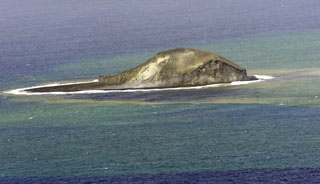Report on Home Reef (Tonga) — 16 May-22 May 2007
Smithsonian Institution / US Geological Survey
Weekly Volcanic Activity Report, 16 May-22 May 2007
Managing Editor: Sally Sennert.
Please cite this report as:
Global Volcanism Program, 2007. Report on Home Reef (Tonga) (Sennert, S, ed.). Weekly Volcanic Activity Report, 16 May-22 May 2007. Smithsonian Institution and US Geological Survey.
Home Reef
Tonga
18.992°S, 174.775°W; summit elev. -10 m
All times are local (unless otherwise noted)
Pumice from the Home Reef eruption that began early-to-mid August 2006 reached the eastern Australian coast in March 2007. A substantial stranding of the pumice in mid-April extended for more than 1,300 km along the Queensland and northern New South Wales coast. Pumice clasts ranged in size from 1-4 cm in diameter, with the largest clasts up to 17 cm in diameter. A visit to the area in February 2007 revealed a pumice mound barely visible over the waves.
Geological Summary. Home Reef, a submarine volcano midway between Metis Shoal and Late Island in the central Tonga islands, was first reported active in the mid-19th century, when an ephemeral island formed. An eruption in 1984 produced a 12-km-high eruption plume, large amounts of floating pumice, and an ephemeral 500 x 1,500 m island, with cliffs 30-50 m high that enclosed a water-filled crater. In 2006 an island-forming eruption produced widespread dacitic pumice rafts that drifted as far as Australia. Another island was built during a September-October 2022 eruption.
Source: Scott Bryan, School of Earth Sciences and Geography, Kingston University

